Top 18 Exercises to Do with Medicine Ball for Full Body Workout
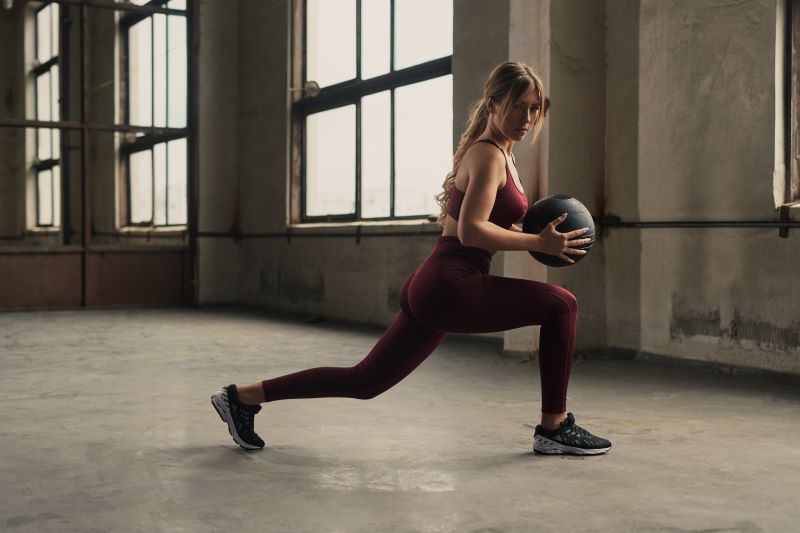
At-home fitness routines have become popular, particularly after the COVID-19 pandemic. Medicine balls have emerged as a popular means of exercising at home to get a toned body. They can generate extraordinary results from your workout routine, adding resistance to your HIIT and cardio.
Are you interested in finding out more about exercises with medicine balls? Keep reading this article to get a comprehensive view.

Table of Contents

What are Medicine Ball Exercises?
Medicine ball workouts involve using a heavy-weighted ball that helps increase strength, coordination, and flexibility. These exercises usually vary from simple moves like chest bypass to tough ones like slams or twists.
This multifunctional medicine ball allows individuals to do full-body exercises for beginners and advanced fitness enthusiasts who want to introduce dynamic resistance into their training workouts.
18 Best Medicine Ball Exercises
If you plan to work out with a medicine ball, there are multiple ways. Here is our hand-picked list that you can start practising today:
Arms and Shoulders Medicine Ball Exercise
1. Triceps Extension
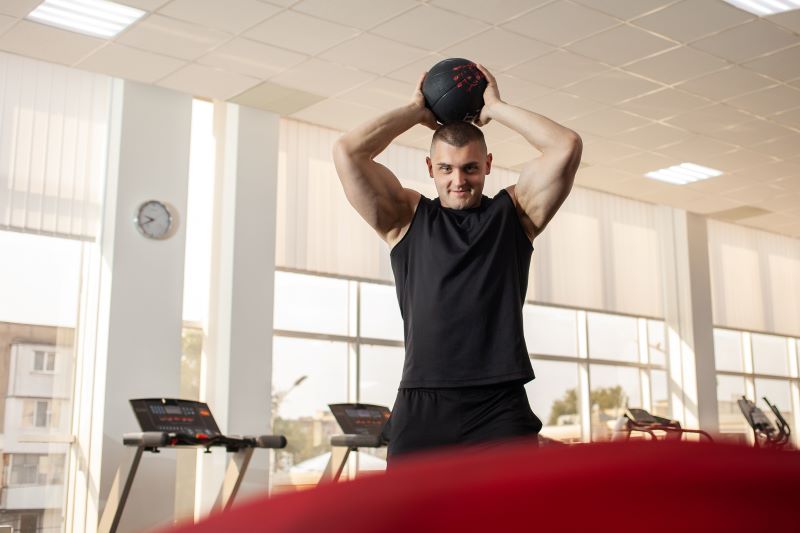
This type of exercise can improve your arm muscles, improving your triceps. Most bodybuilders and athletes prefer this workout to strengthen arm muscles.
Start by standing in a comfortable position or sitting on a chair. Make sure to keep your core engaged. Hold a medicine ball in your hands and extend your arms overhead. The inner parts of the arms should graze your ears.
Now, bend your elbows and lower the ball behind your head. The arms should form a 45-degree angle. Keep squeezing the triceps to straighten your arms. Then, bring the ball back to the starting position.
This workout targets the arm muscles and strengthens the elbow and shoulder muscles. The overhead triceps extension helps work these muscles and increase mobility.
If you have problems with your arms and shoulder muscles, this exercise might not suit your health. You can also reduce its intensity by choosing a lighter medicine ball.
2. Biceps Curl
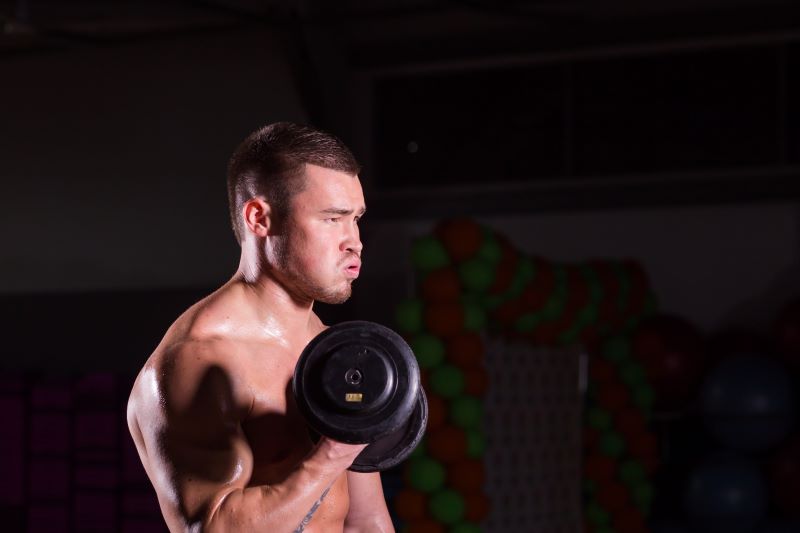
The biceps curl should be mentioned while listing the best exercises with a medicine ball. It helps tone the arm muscles and increase their strength.
Stand on the floor, keeping your feet shoulder-width apart. Hold the medicine ball close to your chest with both hands. Slowly lower the ball towards the ground while keeping the elbows close to the body. Make sure that the arms are entirely extended. Now, curl the ball back up to your chest and lower it back to the starting position. Repeat this process.
Biceps curl increases body and muscle strength. Mainly, the muscles on the upper arm improve with this exercise. Moreover, it also helps to isolate the biceps, ensuring that these stand out in your body.
Excessive and intensive training can harm your body and arm muscles. You should avoid this exercise if you have weak arms or arm injuries. The intensity of this exercise increases with the ball's weight, so select the ball carefully.
3. Circles
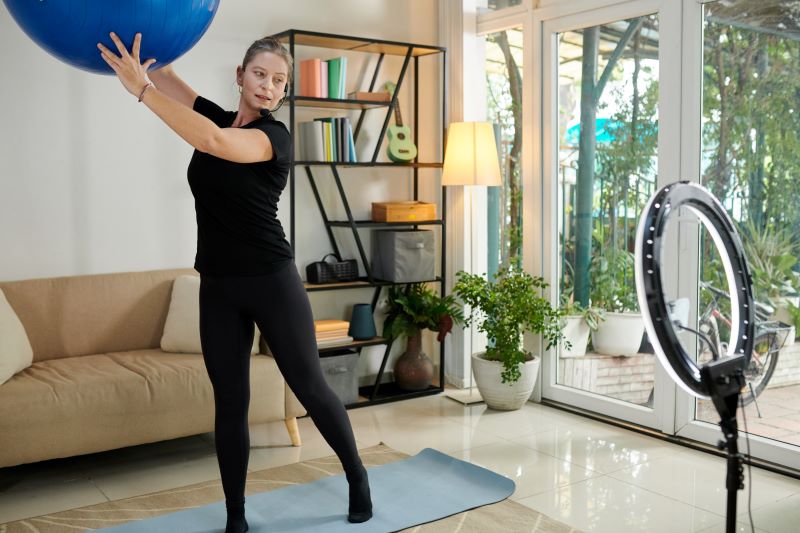
This is one of the most popular exercises with a med ball. The circles target your hands and shoulders, burning extra fat and calories. They also help make these muscles flexible and pain-free.
Stand on the floor, keeping your feet shoulder-width apart. Hold the medicine ball straight overhead. Now, brace your core and start moving your extended arms clockwise. Twist your core to draw a circle with your movement. Keep your feet stationary. Repeat this movement 8-10 times.
This exercise again targets the shoulders and upper body parts. It helps to tone your upper body while strengthening your core. Moreover, it improves the shoulder's range of motion while reducing the chances of injuries and accidents in the future. It can also assist in burning excess calories.
This exercise might not suit you if you have sprains or wrist pain. Those who are recovering from shoulder injuries should also avoid it. If you feel pain in your hands or shoulders, reduce the intensity of the workout immediately.
Chest and Back Medicine Ball Exercise
4. Rolling Push-Up

This exercise is a kind of push-up with a medicine ball. It helps to improve the upper body parts and muscles.
Start with a typical high plank on the ground, placing the medicine ball on one side. Place one hand on the ball. Keep your weight on the standing hand and complete a press-up position. Once your body is raised, roll the ball to the opposite hand. Keep repeating this process.
This exercise helps strengthen the chest, shoulders, arms and core muscles. You can enhance the strength of the upper body part with this exercise and improve the overall stability.
This exercise might require you to place all your weight on the arm muscles, which can be pressurising. You can avoid this routine if you are experiencing weakness or pain in the arms and shoulders.
5. Superman
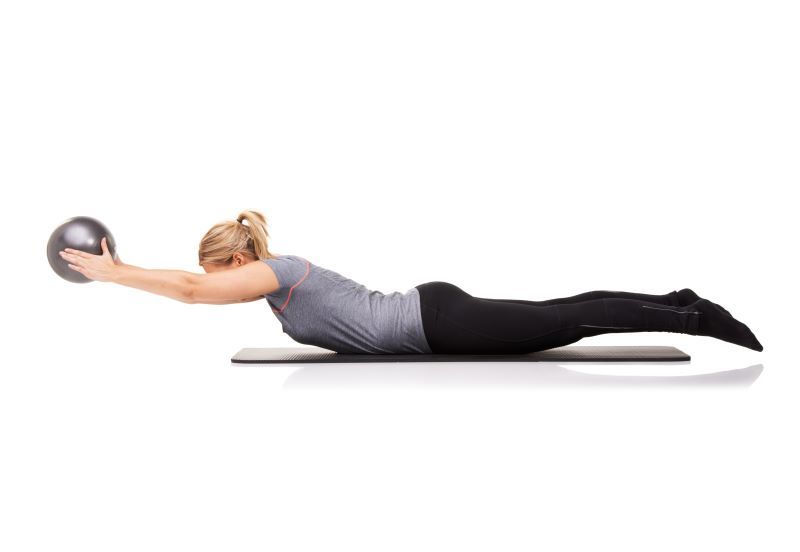
Even though this exercise looks and sounds simple, it might be challenging. Adding a heavy medicine ball makes it more difficult.
To start, lie on your stomach while keeping your arms extended overhead. Grip a medicine ball and hold it over your head. Keep your neck straight and neutral, and engage your core. Try to raise your upper body with the help of your back and glute muscles.
Next, raise your legs off the ground as high as convenient. Now, pause for a few seconds and return to the original position. Repeat the position at least ten times.
This exercise can strengthen the core, lower back, and glutes. It can also help improve the hamstrings, shoulder muscles, arm muscles, and bone strength.
If you are facing sprains or injuries in the back or shoulder muscles, avoiding this exercise can benefit you now. You can choose a lighter medicine ball to reduce the intensity of the exercise.
6. Wall Ball
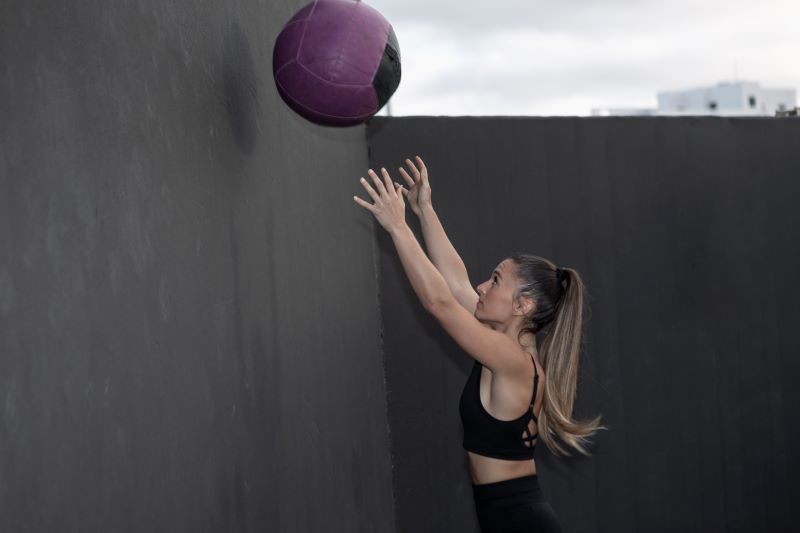
It is one of the most popular and accessible top exercises with a medicine ball. It helps to increase strength, mobility, and mental concentration.
For this exercise, stand on the floor a few steps from a wall. Hold the medicine ball to your chest and bend your knees before throwing it over a marker on the wall. You can let the ball drop to the floor or try to catch it. Keep bending your knees and absorb its impact. Repeat the process several times.
This exercise is excellent cardio, improving your heart rate and health. Apart from that, this routine also helps to burn your body's extra fat and calories. It strengthens the muscle groups.
Remembering your physical strength, you must carefully choose the medicine ball and its weight. You can avoid this routine if you are recovering from arm injuries.
Legs and Glutes Medicine Ball Exercise
7. Single-Leg Squat
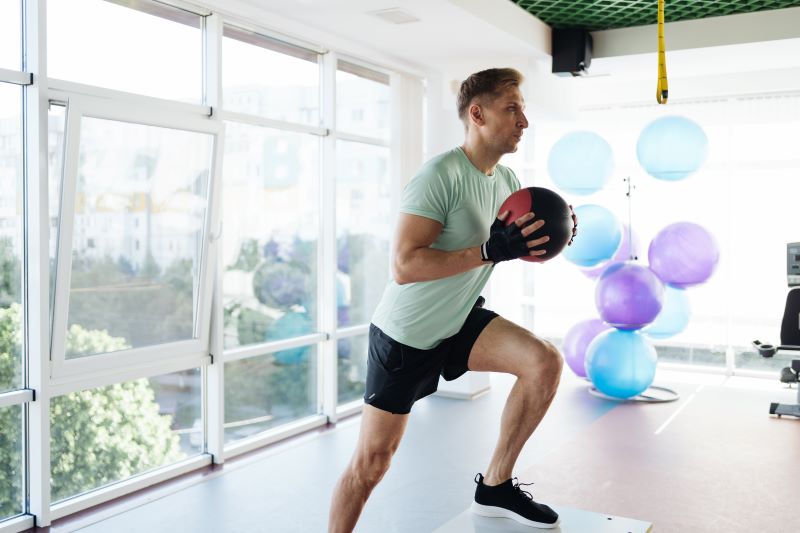
Squatting helps to increase the strength of the lower body parts. The challenge and intensity increase when you use one leg and a medicine ball.
Start by holding a medicine ball in front of your belly button. Then stand, keeping your feet shoulder-width apart and bending your knees slightly. Lift your right foot off the ground and extend it before you.
Now, lower your body into a squat and come to the position of sitting on an imaginary chair. Keep your knees safely positioned over the feet. Return to the starting position and then switch the legs. Keep repeating the process.
Squats are an impressive way of toning the legs and glutes. Using a single leg, this exercise will help further strengthen the core and increase flexibility.
If you face pain or injuries in the lower part of the body, squats might not be suitable for you. Moreover, you should avoid spending much time if you start feeling pain in your body.
8. Single-Leg Deadlift
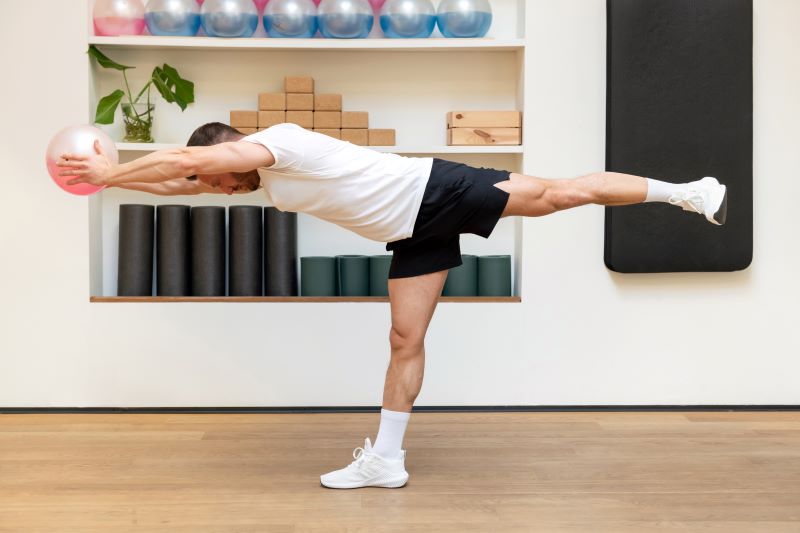
This exercise is essential for maintaining stability for a long time. It helps avoid imbalance even with the growing weakness of the legs.
Stand on the floor while holding the medicine ball straight before you. Bend your right leg slightly, then bend your hips while allowing your torso to fall forward. Extend your left leg out behind you while keeping your back straight.
Make sure that your core is tight and your neck is neutral. Keeping your torso parallel to the ground, return to your upright position. Repeat this position.
This exercise promotes synergy between hip hinge movement, shoulders, and core. Moreover, it develops single-leg balance, which increases stability in older age. Apart from that, you can also improve your mobility through the hips and legs.
As this workout routine can be slightly technical, it is advisable to attempt it only with professional help. If you have weak legs or leg injuries, you can skip this exercise from your workout routine as long as you recover.
9. Side Lunge
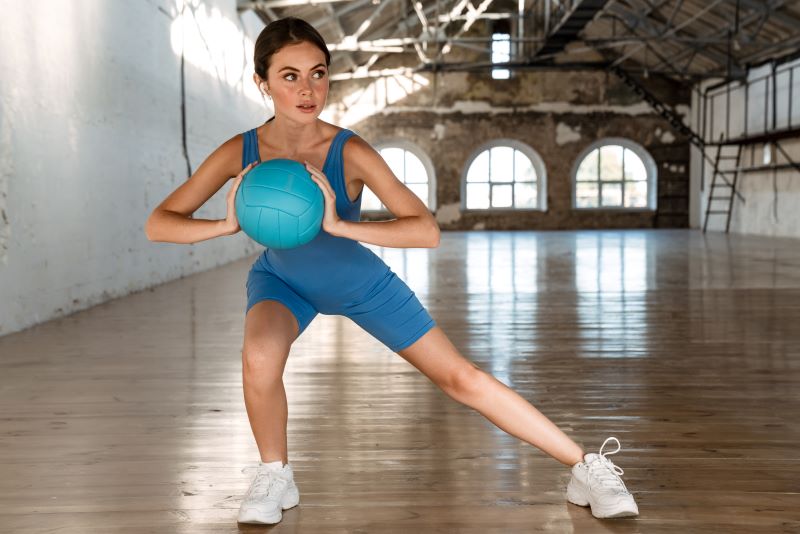
Working out to strengthen the sides is as essential as working out for the back. Side lunges can be great ways to increase flexibility and overall stability.
Start by standing on the floor and keeping your feet shoulder-width apart. Hold the medicine ball to your chest. Now, take a significant step to the right side. As your feet reach the ground, bend your right knee and keep your hip back with a one-legged squat position.
Make sure that the left leg is straight. Push through your right foot and return to the original starting position. Keep repeating this for both legs.
Side lunges are beneficial for developing overall balance, strength, and stability. They work with your inner and outer thighs, reducing the appearance of cellulite. They also make your body more flexible by training it to move side to side with easy twisting movements.
Side lunges might put pressure on the knees and thighs. Hence, avoid this exercise if you have intense pain or injuries in these areas. Moreover, if you have weak legs, avoid practising this workout routine for a long time.
10. Romanian Deadlift
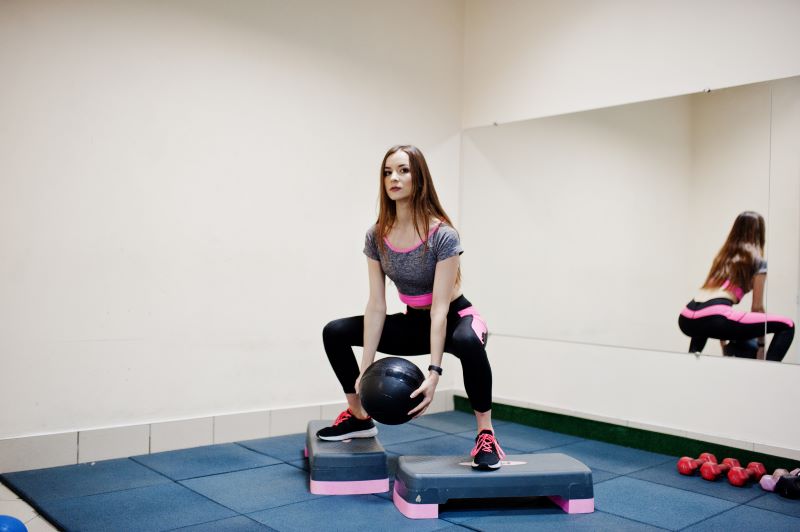
The Romanian Deadlift with a medicine ball is great for strengthening your hamstrings, glutes, and lower back. Using the medicine ball also helps engage your core muscles.
To do this exercise, stand with your feet hip-width apart and hold the medicine ball in front of your thighs with both hands. Slightly bend your knees and hinge at your hips, lowering the ball towards the ground while keeping your back straight.
Lower the ball until you feel a stretch in your hamstrings, then squeeze your glutes and use your hamstrings to lift back up to the starting position. This exercise helps improve flexibility in your hamstrings and strengthens your lower body.
Abs Medicine Ball Exercise
11. Hay Baler
It is another simple yet effective exercise using a medicine ball. It helps to tone and flex your abdominal muscles.
Start by kneeling on your right knee while keeping your left foot backwards. Curl your toes under, forming a 90-degree angle. Hold the medicine ball in both hands while keeping your torso perpendicular to the floor. Bring the medicine ball towards your right hip, keeping your body straight. Transfer it diagonally across your body. Repeat the process with your right foot.
Hay baler is a beneficial exercise, as it targets the muscles of your abdomen. These include the internal and external obliques, rectus abdominis, and transverse abdominis. These muscles become more assertive, while your shoulder and back muscles are also improved with this workout routine.
This exercise mainly involves the legs and arm muscles. Thus, if you have intense pain or injuries in these areas, you can skip it from your workout routine.
12. Russian Twist
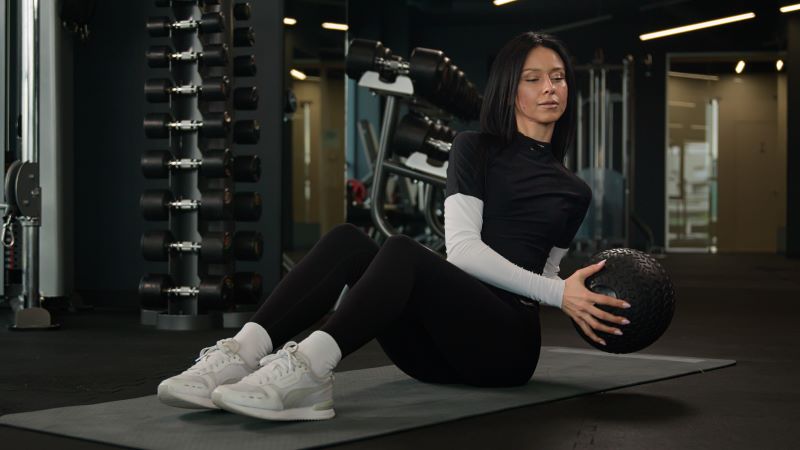
Consider Russian twists if you want to do a full-body workout with a medicine ball. They are essential if you are a fan of abs.
For this exercise, sit on the floor, bending your legs at a 45-degree angle. Your feet should be touching the floor. Now, extend your arms while holding the medicine ball in front. Next, start twisting your torso after bracing your core tightly.
Move the medicine ball to the right side of your body until it almost touches the ground. Return to the middle and repeat this procedure on the left side.
Including Russian twists in your workout routine will strengthen your core and shoulders. Moreover, it helps build rotational movement, a significant requirement for sportspeople and athletes.
One of the significant challenges of doing Russian twists is compression. It requires you to stay in the half-sit-up position for a long time, which can cause massive contraction of the abdominals and hip flexors. This, in turn, produces excess compression of the lumbar spine. Thus, only do this exercise if you have enough strength in the spinal and abdominal areas.
13. Toe Touch
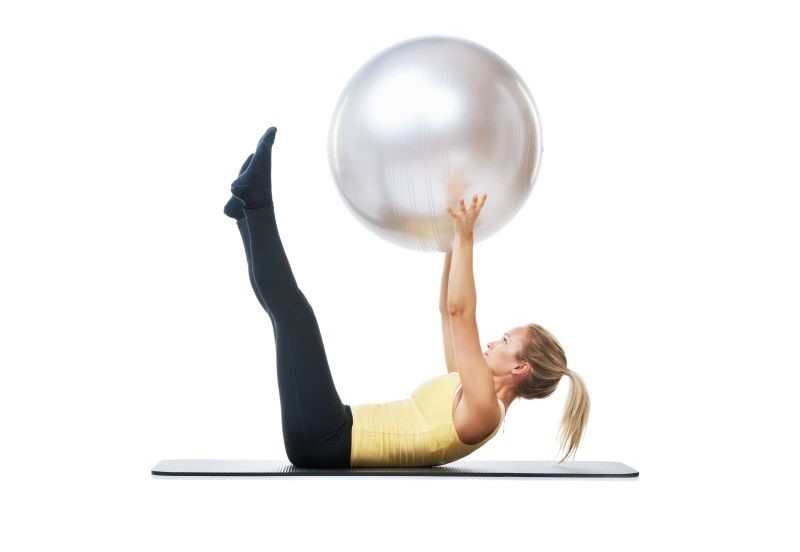
While considering workouts for beginners with a medicine ball, a toe touch can be essential. It helps to develop abs and tone your muscles.
Lie on your back while keeping your arms and legs extended before you. Hold your medicine ball in your hands, extending it in front. Engage your core and lift your arms and legs straight up. Make the arms and legs above your mid-body while crunching upward to ensure they touch each other. Now, slowly come back to the starting position. Keep repeating the process.
This exercise benefits most people since it engages the abdominal walls and tones the abs. It also helps trim the waist and shed extra fat and calories. It strengthens the core, thereby improving posture and flexibility.
This exercise requires you to engage your core and shoulder muscles. If you have pain or injuries in these areas, try to avoid it.
14. Crunches
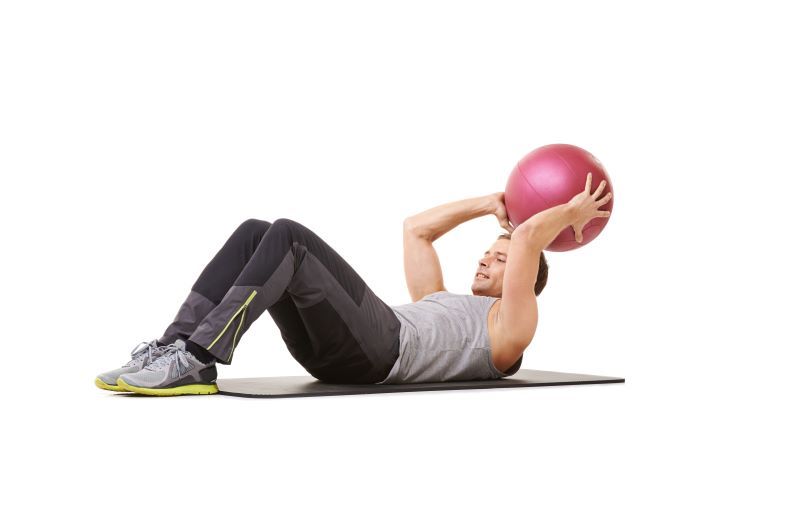
The crunch with a medicine ball is an effective exercise for strengthening your abdominal muscles. The medicine ball adds extra resistance, making the exercise more challenging and effective.
To do this exercise, lie on your back with your knees bent and feet flat on the floor. Hold the medicine ball with both hands and extend your arms straight towards the ceiling. Engage your core muscles and lift your shoulders, reaching the ball towards your knees.
Keep your lower back pressed against the floor. Lower your shoulders back down to the starting position and repeat. This exercise targets your abs and helps build core strength.
The added weight of the medicine ball increases the intensity, making your muscles work harder. Including Crunches with a medicine ball in your workout routine can help you achieve a stronger, more defined core.
Full-Body Medicine Ball Exercise
15. Slams
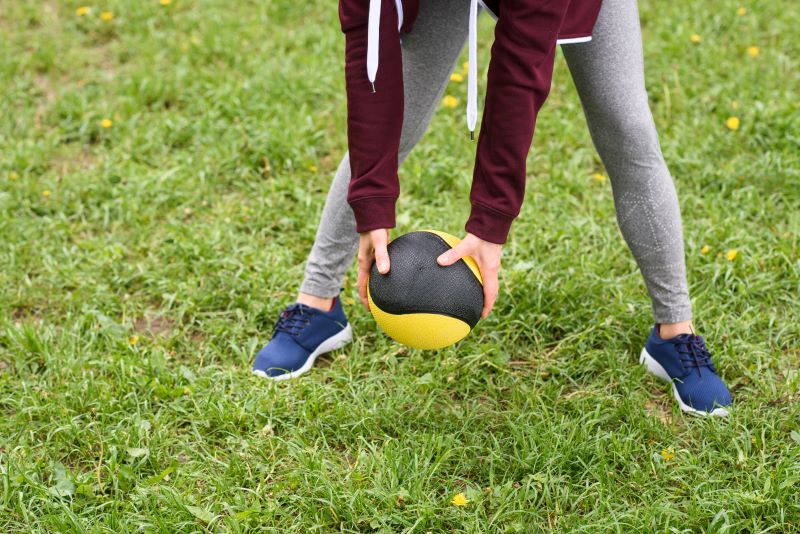
Slams can be perfect core exercises with a medicine ball if you prefer cardio over an intense workout. They help develop power and strength while improving heart health.
Stand on the floor, keeping your feet shoulder-width apart. Hold the medicine ball overhead. Now, bend your hips while keeping your arms extended forward. Next, slam the medicine ball with force and pick it up. Come back to your original position. Perform at least 3-4 sets while repeating the process.
Slams increase your overall muscle density while improving the resting metabolism in your body. Moreover, you can develop glucose metabolism faster with this exercise. Furthermore, it can enhance your mental clarity and heart health.
It is a simple exercise, and anyone can do this. It is up to you to decide the intensity of the slam. However, avoid this exercise if you have pain or injuries in your hands or wrists. Moreover, try to use lighter balls to keep the intensity lower.
16. Overhead Squat
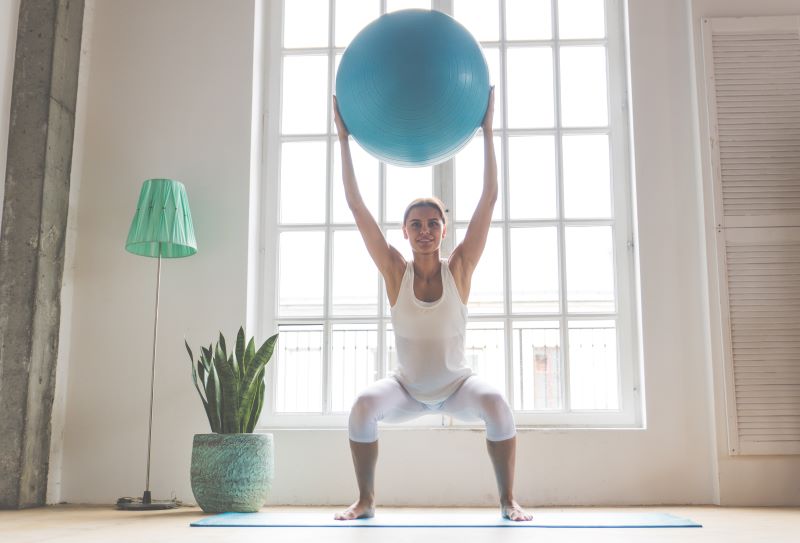
This exercise helps to engage your core, strengthening the entire body. Notably, the lower back becomes more vital with this workout routine. You can keep your entire upper body in shape with this.
Start by standing on your feet, keeping them slightly wider than shoulder-width apart. You need to hold the medicine ball straight over your head. Now, squat down, bend your knees, and push your hips back. Ensure your knees are not bowing inward and keep the thighs parallel to the ground. Push through your heels, squeezing the glutes at the top. Repeat it at least 10-12 times.
This exercise is highly beneficial for strengthening your core and upper body muscles. It boosts your overall strength, ensuring excellent mobility for the longest time. It can help you improve your squat form and overall athletic capabilities.
Overhead squats are easy, and anyone can attempt them. However, if you suffer from intense back pain or injuries in the hands or wrists, you might need to avoid it. Moreover, if you are uncomfortable with the ball's weight, only continue this exercise for a short time.
17. Knee Drive
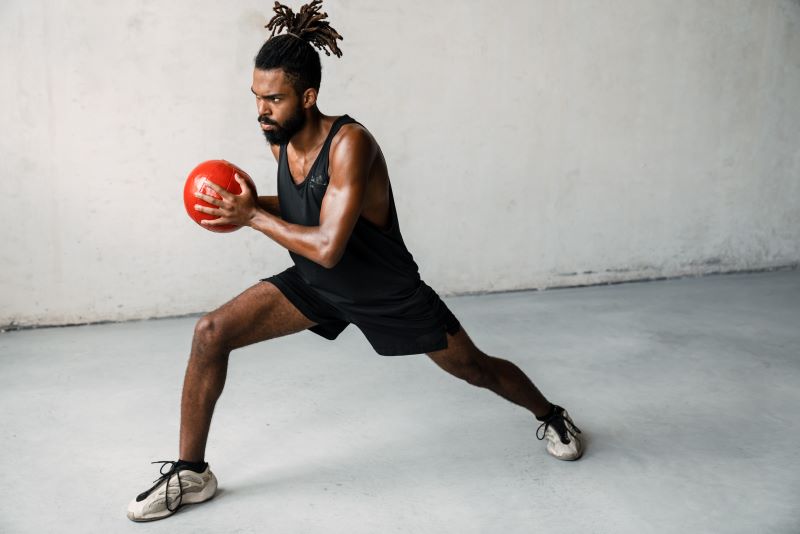
It is another exercise with a medicine ball for beginners. It is essential for improving knees and thigh muscles, and holding the medicine ball further improves arm muscles.
Start this routine, keeping your right leg firmly on the floor. Place it behind you with the toes balancing on the ground. Hold your ball before you, keeping it straight with your back leg. Next, drive your left leg up and bring the medicine ball down so both can reach each other. Repeat this process with the opposite leg and continue 3-4 sets.
As the name suggests, this exercise targets your legs, knees, calves, hamstrings, glutes, and hip flexors. It helps to improve muscle strength, endurance, and coordination in these muscles. It can improve the endurance of the entire lower body.
If you have intense joint pain or hamstring issues, avoid knee drives. You can reduce the number of times you continue this exercise while keeping your health in mind.
18. Rock and Roll-Up

The rock-and-roll-up with a medicine ball is a fun and effective exercise for strengthening your core muscles. It also helps improve your balance and coordination.
To do this exercise, sit on the floor with your knees bent and feet flat on the ground. Hold the medicine ball with both hands close to your chest. Lean back slightly, lift your feet off the ground, and balance on your sit bones.
Rock back gently onto your lower back, then use your core muscles to roll back up to the starting position, coming up to a seated position without letting your feet touch the ground. Repeat the movement, maintaining control throughout.
This exercise engages your abs and helps improve your overall core strength. The rocking motion adds a dynamic element, challenging your balance and coordination. Adding the rock and roll-up with a medicine ball to your workout can improve your ability to stabilise your body during various movements.
Who Should Avoid Exercises With Medicine Ball?
Now that you know the exercises to do with a medicine ball, you should be careful while doing it if you have any of the below health and medical conditions:
Avoid it if you have severe arthritis or recent joint injuries.
It is not recommended for those with chronic back pain or spinal issues.
Pregnant women should consult a healthcare provider before doing these exercises.
Beginners should start with lower weights and ensure proper form to prevent injury.
Be cautious if you have heart conditions or high blood pressure.
Avoid until fully recovered and cleared by a doctor after surgery.
Skip strenuous exercises if you are sick or fatigued.
Safety Precautions to Take While Practising with a Medicine Ball
Given below are a few safety precautions that you should keep in mind while exercising with a medicine ball:
- Consult Your Physician: Ensure you are medically cleared to exercise with a medicine ball, especially if you have pre-existing health conditions.
- Start with Appropriate Weight: Choose a medicine ball weight that matches your fitness level to avoid strain and injury.
- Warm-Up Properly: Begin with a light warm-up to prepare your muscles and joints for exercise.
- Maintain Proper Form: Use correct form and technique to prevent injuries, particularly to your back and shoulders.
- Clear Your Exercise Area: Ensure your workout space is free of obstacles to prevent tripping or accidental collisions.
- Start Slowly: If you're new to medicine ball exercises, begin with basic movements and gradually progress to more advanced routines.
- Avoid Overtraining: Allow your body adequate time to rest and recover between workouts to prevent overuse injuries.
Disclaimer: Practice the above-mentioned exercises under the supervision of a trained practitioner and consult a doctor beforehand to ensure your body is fit enough to perform the required moves/postures.
So, exercises with medicine balls can be beneficial for your health. However, continuing these routines might be slightly challenging because of the ball's weight. Proper precautions and tips from fitness experts will help avoid unnecessary complications.
Affordable Health Insurance Solutions for You and Your Loved Ones














